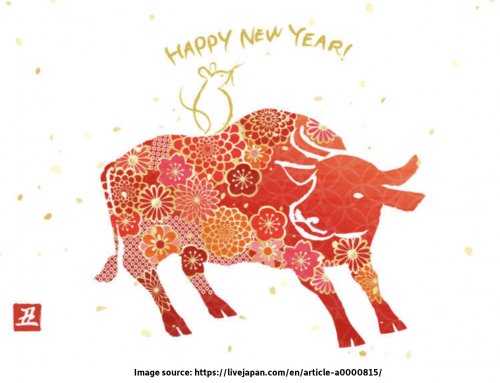
Enjoy a recording of this year’s Mass Greeting and past performances as well.
The Lunar New Year is approaching—New Year’s day is Friday, February 12, in fact. At CAIS we welcome the Lunar New Year with our school’s biggest and most festive community celebration: Mass Greeting or tuán baì 团拜. This year’s Mass Greeting will, of course, be virtual.
There are many countries around the world that celebrate the Lunar New Year. One of the unique ways it is celebrated in Chinese culture—and at CAIS—is by associating each year with a symbolic animal. We are coming to the end of the Year of the Rat and welcoming the Year of the Ox. Why is it, in China, that years are symbolized by animals? What is the origin of this tradition? What meanings are associated with the various animals? And will the Year of the Ox be better than the Year of the Rat—please?
There are many different theories about the origin of the twelve symbolic animals that form a repeating twelve year cycle. The twelve animals or shíèr gè shēngxiào 十二个生肖 are so woven into Chinese culture that people take them for granted and don’t really know how this cultural tradition originated. Scholars have postulated theories linking the origin to astronomy, astrology, animal worship, meteorologic cycles, and totemism. A modern ethnologist named Liu Xiaohan has posited that the twelve symbolic animals actually originated in the Yí 彝 culture, an ethnic minority in the mountains of China’s southern and southwestern provinces. The fact is that no one really knows for sure—the first written reference to the twelve symbolic animals in a form that resembles their modern configuration was in the Eastern Han 东汉 (25-220 CE) by the philosopher Wang Chong 王充 (c. 20-97 CE) in an eclectic collection of his essays called Lùnhéng 论衡 (not on my list of book recommendations). Yet there have been even earlier archaeological discoveries of references—written on bamboo strips—to a cycle of symbolic animals associated with years that date back to the Warring States or Zhànguó 战国 period (475-221 BCE). This is all to say that this stuff has been around for a long time.
Cultural phenomena that have persisted for so many years in China tend to be the subject of much analysis—both folk and scholarly, and to accumulate a lot of imputed meanings and significance. For instance, it is common to associate the qualities of people with the qualities of the animal of their birth year. If you subscribe to this folk belief it would explain why the current class of CAIS fourth grade girls are destined to rule the world (i.e., a lot of dragons). FYI, I’m a rat—unsurprising, no doubt, to some of you. Some families are reluctant to allow their children to marry if the couple’s birth year animals are considered to be an inauspicious match. (I do not recommend you look into this with your current spouse—marriage is challenging enough as it is!) Some animals are domesticated and helpful (horses, oxen, roosters) while others are wild, unpredictable and may wreak havoc on the human world (tiger, snake, rat). Accordingly, both kinds of people (and years) need to be handled with the appropriate care.
Numerology has always played a big role in Chinese culture, ancient and modern; think of the five elements (wǔ xíng 五行), double happiness (shuāngxǐ喜喜), eight honors and eight shames(bā róng bā chǐ八荣八耻), and of course the 888 Campus for our Middle School. The 12 year cycle of symbolic animals corresponds to the 12 Terrestrial Branches (dì zhī 地支), a hopelessly complicated (for me, anyway) system used in times past to designate days, months, and years. Each of the 12 symbolic animals corresponds to one of the Terrestrial Branches. If you have any Chinese calligraphy hanging in your home, the artist probably signed it with the date on which it was painted, but you are unlikely to to see anything like “October 1, 1985” or “December 27, 2019”—instead you’ll see a combination of the 12 Terrestrial Branches and 10 Heavenly Stems and you’ll need to visit Google (or Baidu) to figure out the corresponding dates on the Gregorian calendar. You can imagine the market for fortune tellers based on birth date, symbolic animal, potential marriage partner, etc, and most open air markets in China have a few fortune tellers who will happily predict your fate or choose your wedding day based on a combination of these factors, including your birth year animal. I suppose that nowadays you can probably get this service via WeChat, but I’m not that sophisticated of a user.
So, is there anything significant about the Year of the Ox? In fact, there is. There is an often repeated saying in Chinese, “may your child become a dragon” (wàng zǐ chéng lóng 望子成龙). As a parent, I would actually prefer that my child become an ox. Strong and quiet, the ox lowers its head, focuses on what is in front of it, and powers ahead, often pulling something heavy, like a plow through the muck. It labors selflessly, all day, on behalf of others, without complaint and requiring no praise, no reward, no special treatment. Legend has it that the twelve animals raced across a river to determine their order in the 12 year cycle. The ox was the strongest swimmer, and rat the weakest. So the ox carried the rat on its back, and reaching the other bank of the river, the rat jumped to dry ground. Consequently the rat is the first animal in the 12 year cycle, the ox second. 2020, the Year of the Rat has presented us with enormous challenges. It is precisely virtues of the ox that will get us through 2021 and the pandemic. So I hope that we can celebrate the Lunar New Year by taking a lesson from the ox.

